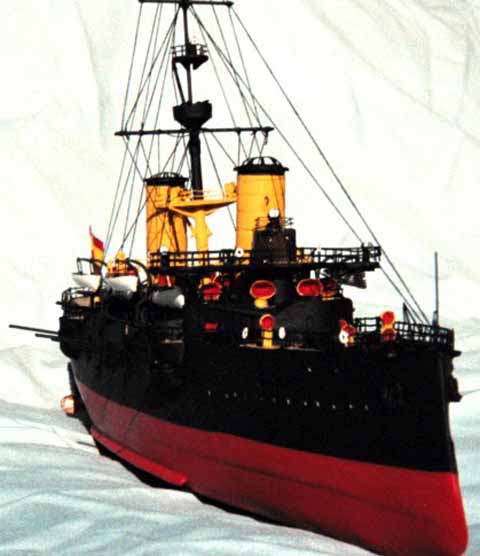By Germà Coendersi

1/350 Spanish cruiser Cristobal Colon (Box 261)

| The armored cruiser Cristóbal Colón is the last of the
Spanish ships lost at the Santiago Battle. At the first stages of the battle
she managed to escape to the west while the US squadron was busy with other
ships of the Spanish squadron. Initially she was the fastest ship afloat,
as the theoretically faster USS Brooklyn did not have time to couple the
second pair of engines to the shafts and the odds for her to escape were
good. However, once the rest of the Spanish fleet had been defeated, a
big portion of the US squadron (Brooklyn, Texas and Oregon) chased the
Colón. When the high quality coal was over, Colón started
losing speed and when she came within range of the large US guns Colón
opened up the sea valves and ran aground to spare the lives of the crew
in a hopeless fight.
|
| Vital statistics
History. Laid down: 1895; launched: 1896; completed: 1897; scuttled:
Dimensions: length: 100m; beam: 18.2 m; draught: 7.8 m; displacement:
Armament: 2x10 in. (254 mm.) in single turrets fore and aft (never installed because the original Armstrong supplied guns were worn out, and were rejected by the government in spite of the pleas of the admiralty, who argued old guns to be better than no guns. Replacements did not arrive in time), 10x6 in (152 mm) in an enclosed battery, 6x4,7 in (120mm) in upper deck open mounts, 10x 57mm, 10x37 mm, 2 machine guns, 5 torpedo tubes. Armor: nickel steel. 5.9 in (150mm.) belt; 5.9 in battery; 5.9 in turrets; 1.2 in (30 mm.) deck. Engines: 2 VTE engines; 24 Niclause watertube boilers; 13,000 hp; 19.5 knots. Endurance @10 knots: 8300 miles. Complement: 543
This ship belongs to the very successful Garibaldi class, Italian built cruisers and to the largest series of armored cruisers ever built (4 went to Argentina, 3 to Italy, 2 to Japan and 1 to Spain). The Japanese ships were tested many times in battle, and were considered to do very well, even in line-of-the-battle duties. In its actual state she arguably was the best ship in the squadron of Admiral Cervera, and, with the intended 10 in guns, in the whole Spanish fleet. Her major assets were speed, the large portion of the hull that was protected (the waterline end to end and up to the upper deck amidships) and a fully armored powerful battery of 10 quick firing 6 in guns. Of course she was inferior to such ships as Iowa or Brooklyn, but if we compare her to ships of similar displacement in the US fleet (basically the USS Texas and the ill-fated USS Maine), the Cristóbal Colón would have been a good match. It had a lighter main armament, though better sited, and with higher shell velocity and rate of fire, a heavier secondary armament, higher speed and thinner armor, though covering a larger portion of the hull. Up to now, no manufacturer has embarked in 1898 era Spanish ships (though there exists a 1/700 Pelayo released by Jadar Ships). Thus it is hard to find companions to the many available US participants in the Santiago battle (up to now, Iron Shipwright 1/350 Iowa, Texas and Brooklyn, and YS master pieces 1/350 Oregon) and other US ships of the era (the ram Katahdin, the cruisers Maine, Columbia, Olympia and Charleston, and the monitors Monterey, Puritan and Amphitrite, all by Iron Shipwirgt). Recently Box 261 has released a 1/350 Kasuga, one of the Japanese sister ships of the Cristóbal Colón. The differences between both ships are noticeable, to begin with in dimensions, which I did not know how to fix. However, lacking anything better to start from I embarked on my first conversion project. The main changes I did were: * fill the hull recessions present in Kasuga widen the arcs of fire
of
I built the model with the two 10 in guns installed, as they should have been, ready to fire a broadside. At least, historical errors can be fixed in models. I painted her as she was in her voyage from Spain to Cuba. At the Santiago battle she appeared painted black overall. |
| The major sources I used were photographs in
Coello Lillo, Juan Luis (2001): Buques de la Armada española
a través de
I want to thank Santi Gutiérrez for his many comments and suggestions.
|
